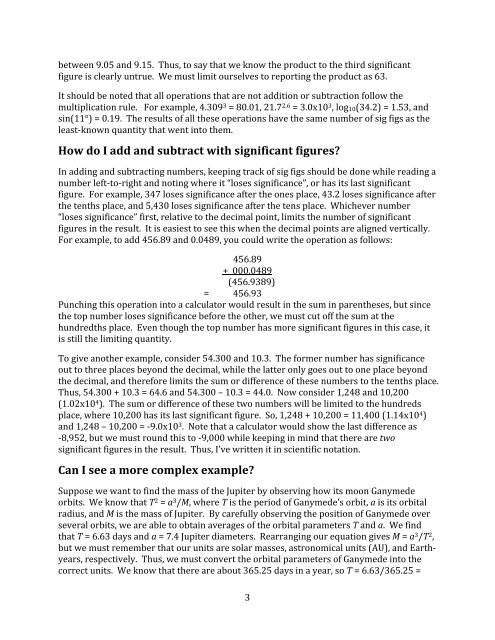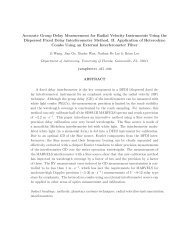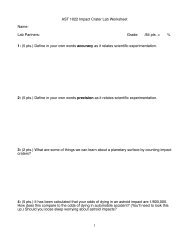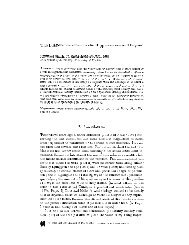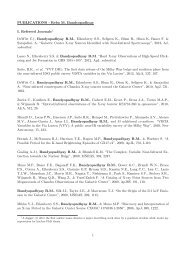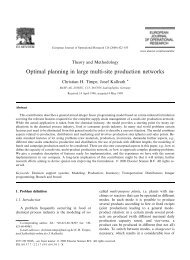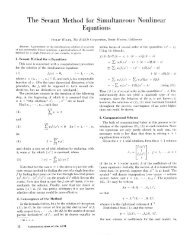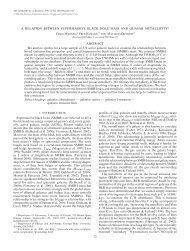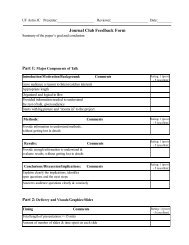Introduction to significant figures - Astronomy
Introduction to significant figures - Astronomy
Introduction to significant figures - Astronomy
Create successful ePaper yourself
Turn your PDF publications into a flip-book with our unique Google optimized e-Paper software.
etween 9.05 and 9.15. Thus, <strong>to</strong> say that we know the product <strong>to</strong> the third <strong>significant</strong> figure is clearly untrue. We must limit ourselves <strong>to</strong> reporting the product as 63. It should be noted that all operations that are not addition or subtraction follow the multiplication rule. For example, 4.309 3 = 80.01, 21.7 2.6 = 3.0x10 3 , log10(34.2) = 1.53, and sin(11°) = 0.19. The results of all these operations have the same number of sig figs as the least-‐known quantity that went in<strong>to</strong> them. How do I add and subtract with <strong>significant</strong> <strong>figures</strong>? In adding and subtracting numbers, keeping track of sig figs should be done while reading a number left-‐<strong>to</strong>-‐right and noting where it “loses significance”, or has its last <strong>significant</strong> figure. For example, 347 loses significance after the ones place, 43.2 loses significance after the tenths place, and 5,430 loses significance after the tens place. Whichever number “loses significance” first, relative <strong>to</strong> the decimal point, limits the number of <strong>significant</strong> <strong>figures</strong> in the result. It is easiest <strong>to</strong> see this when the decimal points are aligned vertically. For example, <strong>to</strong> add 456.89 and 0.0489, you could write the operation as follows: 456.89 + 000.0489 (456.9389) = 456.93 Punching this operation in<strong>to</strong> a calcula<strong>to</strong>r would result in the sum in parentheses, but since the <strong>to</strong>p number loses significance before the other, we must cut off the sum at the hundredths place. Even though the <strong>to</strong>p number has more <strong>significant</strong> <strong>figures</strong> in this case, it is still the limiting quantity. To give another example, consider 54.300 and 10.3. The former number has significance out <strong>to</strong> three places beyond the decimal, while the latter only goes out <strong>to</strong> one place beyond the decimal, and therefore limits the sum or difference of these numbers <strong>to</strong> the tenths place. Thus, 54.300 + 10.3 = 64.6 and 54.300 – 10.3 = 44.0. Now consider 1,248 and 10,200 (1.02x10 4 ). The sum or difference of these two numbers will be limited <strong>to</strong> the hundreds place, where 10,200 has its last <strong>significant</strong> figure. So, 1,248 + 10,200 = 11,400 (1.14x10 4 ) and 1,248 – 10,200 = -‐9.0x10 3 . Note that a calcula<strong>to</strong>r would show the last difference as -‐8,952, but we must round this <strong>to</strong> -‐9,000 while keeping in mind that there are two <strong>significant</strong> <strong>figures</strong> in the result. Thus, I’ve written it in scientific notation. Can I see a more complex example? Suppose we want <strong>to</strong> find the mass of the Jupiter by observing how its moon Ganymede orbits. We know that T 2 = a 3 /M, where T is the period of Ganymede’s orbit, a is its orbital radius, and M is the mass of Jupiter. By carefully observing the position of Ganymede over several orbits, we are able <strong>to</strong> obtain averages of the orbital parameters T and a. We find that T = 6.63 days and a = 7.4 Jupiter diameters. Rearranging our equation gives M = a 3 /T 2 , but we must remember that our units are solar masses, astronomical units (AU), and Earth-years, respectively. Thus, we must convert the orbital parameters of Ganymede in<strong>to</strong> the correct units. We know that there are about 365.25 days in a year, so T = 6.63/365.25 = 3


